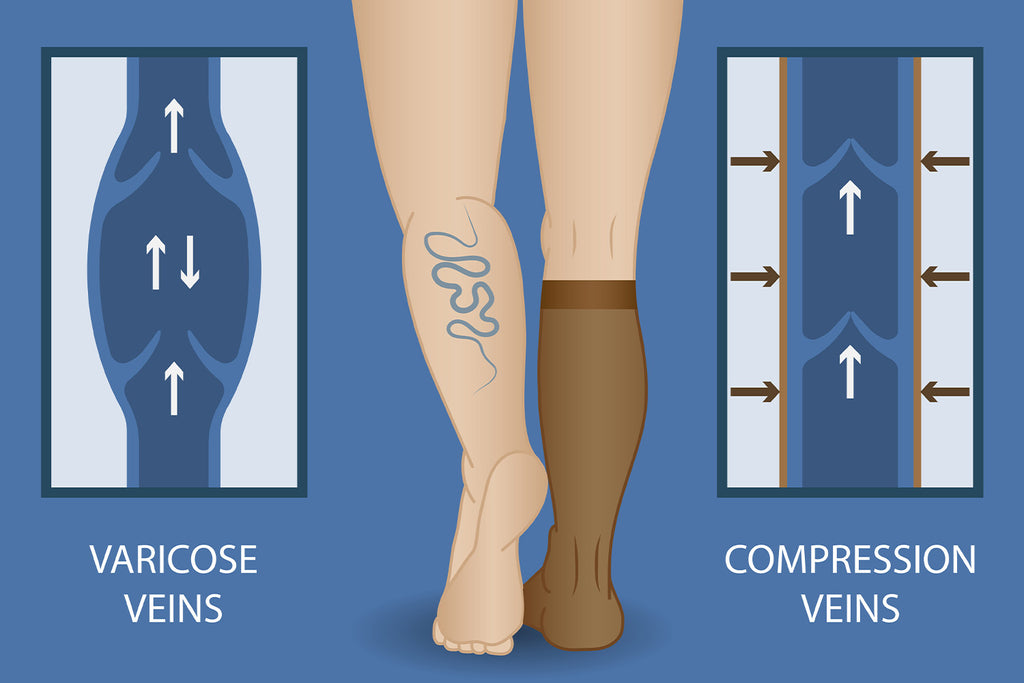
Medically reviewed by Dr. Michael Darder OBGYN — Written by Kari Johnson
Updated April 13, 2022

Compression therapy gives you an inexpensive and easy way to improve your circulation. Medical compression gear shouldn't be confused with non-medical pressure garments, such as shapewear and girdles, which are intended to slim the body.
Instead, most compression garments deliver proven medical benefits for your vascular system and your overall health. At the same time, they apply gentle pressure that can easily fit into your lifestyle.
Although many types of compression garments exist, they mostly fall into the following categories:
- Post-Surgical Compression
- Athletic Compression
- Compression for the Prevention & Treatment of Medical Conditions
Compression socks, like the ones we sell at Comrad, serve many functions. They are versatile enough to provide support after surgery, during a workout, and throughout the day.
Post-Surgical Compression
After specific surgical procedures, doctors may recommend a surgery compression garment to aid in the recovery process. These garments can include TED Hose, graduated compression socks, and other forms of surgical compression.
TED Hose
After major orthopedic surgeries, patients have an increased risk of dangerous blood clots in the deep veins. Of the total population of orthopedic surgery patients, it's estimated that 3 percent will develop deep vein thrombosis (DVT), and 1.5 percent will go on to develop pulmonary embolism (a potentially fatal complication of DVT).
TED is an acronym that stands for Thrombo-Embolus Deterrent. This type of compression hosiery measures 20 millimeters of mercury (mmHg) or less, and it applies uniform compression to all parts of the legs.
By improving blood circulation, TED hose make it more difficult for blood clots to form. TED hose are a tool used to reduce DVT risk after surgery, especially for bedridden patients.
Graduated Compression Socks
Once a surgical patient can move and walk around, doctors often recommend switching from TED hose to graduated compression socks or stockings. These garments offer extra support to the vascular system, helping it move blood against the force of gravity by providing stronger compression at the ankle and less compression at the calf.
Other Forms of Post-Surgical Compression
After some surgeries, such as liposuction and breast reduction, doctors may prescribe surgical compression garments to promote wound healing and reduce swelling. For example, an elastic compression bra is often recommended as part of post-surgery care following breast surgery.
Athletic Compression

Athletes report many benefits from the use of compression during and after workouts. Studies suggest that perceptions of delayed onset muscle soreness (DOMS) and fatigue can be reduced using compression gear. In addition, compression therapy improves overall blood circulation, helping to clear the body of creatine kinase and other waste products.
Many different styles of athletic compression are available, but socks, tights, and shorts are some of the most popular styles.
Compression Knee-High Socks
Knee-length compression socks support the bones, muscles, and ligaments in your feet, helping to protect you from overuse injuries. Research also suggests that leg compression helps with postural stability and balance.
Compared to shorter socks, knee-high styles offer the added benefits of graduated compression. Studies suggest that athletes who use graduated compression socks may show improvements in functional recovery, reductions in lactic acid levels, and increased feelings of comfort.
Compression Ankle Socks
For athletes who enjoy an ankle-length style, Comrad offers targeted compression with a low profile. Our ankle socks prevent your feet from swelling during exercise. When you don't collect extra fluid in the feet, it's easier to maintain a snug fit in your footwear.
As a result, you may experience fewer blisters, less chafing, and a better stride. Plus, gentle pressure supports alignment and posture, allowing you to feel less impact with each step.
Compression Sleeves
Compression arm sleeves usually apply compression from the wrist to the upper arm. Leg sleeves may be worn on the lower leg or over the entire leg.
Compression knee braces are also available. For athletes, compression sleeves provide stability by protecting the alignment of the elbow or the knee. These garments come in a wide range of fabrics, including neoprene and other thick materials.
Leg sleeves do not prevent swelling in the feet, but they sometimes provide graduated compression with more pressure at the ankle than the calf. Like compression socks, graduated sleeves may be worn to reduce creatine kinase, improve functional recovery, and decrease perceptions of soreness.
Compression Shorts & Tights
Leg compression garments are sometimes manufactured with a waistband. You can buy athletic compression in the form of underwear, shorts, or tights. Tights differ from underwear and shorts in that they provide coverage for the lower legs and the upper legs.
Studies show a reduction in impact force and an improvement in vertical jump performance using lower-body compression garments. These garments can be layered under other workout gear or worn alone.
Compression Shirts & Bodysuits
Compression shirts and bodysuits apply uniform pressure to the torso. Research suggests that upper body compression garments may improve an athlete's perceptions of posture and stability. Beyond that, upper body compression may aid athletic recovery by contributing to a lower-body temperature after a tough workout.
Compression for the Prevention & Treatment of Medical Conditions

Doctors frequently prescribe compression garments to prevent medical problems, such as DVT or varicose veins. For patients with existing medical conditions, a doctor may prescribe compression therapy to treat swelling, pain, or other uncomfortable symptoms.
Treatment of Lymphedema
Lymphedema is caused by improper functioning of the lymphatic system. Poor drainage of lymph fluid can lead to swelling, tenderness, and pain in the affected area.
A doctor may prescribe arm sleeves to treat the symptoms of lymphedema in the arms. For lymphedema symptoms in the legs, graduated compression socks or stockings function as a therapeutic treatment.
Treatment of Chronic Venous Insufficiency and Venous Ulcers
Compression socks can be used to prevent the early stages of chronic venous insufficiency (CVI) in at-risk patients. As CVI progresses, weak vascular structures can lead to the failure of veins and a cascade of painful symptoms.
By supporting healthy vascular function, compression garments help prevent those structural failures. For example, most doctors recommend that pregnant women wear compression socks or stockings during the third trimester of pregnancy to avoid varicose veins.
Once a patient develops CVI, compression socks and stockings can be used to relieve the condition’s symptoms. By supporting the circulatory system, compression socks can reduce the pain and swelling that results from venous reflux and vein damage.
In the most extreme stages of CVI, patients develop venous ulcers. A systematic review of the scientific literature shows strong scientific evidence to support using graduated compression socks to promote ulcer healing and prevent reoccurrence.
Treatment of DVT & Post-Thrombotic Syndrome
Compression socks promote healthy blood flow and lower your risk of developing a deep vein blood clot. If you've already experienced DVT, or you suffer from a complication called Post-Thrombotic Syndrome (PTS), you are more likely to develop blood clots in the future.
The use of compression garments reduces the symptoms of DVT and PTS, which may include heaviness, itching, leg pain, swelling, and leg ulcers. In combination with other medical prescriptions, compression therapy aids with prevention and treatment.
Treatment of Osteoarthritis or Rheumatoid Arthritis
Doctors sometimes recommend compression gloves as a way to improve circulation to the hands. They can help relieve cramps or pain caused by certain medical conditions, such as osteoarthritis or rheumatoid arthritis.
What Form of Compression Should You Try First?

If your doctor prescribes compression clothing to treat a medical condition or aid in surgical recovery, you should follow the physician's guidance. They may recommend compression stockings or a compression sleeve with a specific amount of compression. If that's the case, follow your doctor's guidance.
On the other hand, if you're simply looking to improve your overall circulation or enhance your exercise routine, compression socks give you immediate benefits. They're easy to wear and inexpensive. Because you can pair them with all of your favorite athletic gear, they're also extremely versatile.
At Comrad, we make socks in a range of sizes—with options for extra wide calves. You can try a range of compression strengths and fabric options, so you’re bound to find the perfect fit.
Sources:
Blood Clots in Orthopedic Surgery Fact Sheet | National Blood Clot Alliance
Breast Reduction Surgery | Mayo Clinic
Evaluation of a lower-body compression garment | Journal of Sports Sciences
Graduated Compression Stockings | Canadian Medical Association Journal
Graduated Compression Stockings and Delayed Onset Muscle Soreness | The Engineering of Sport
Hemorrhoids and Varicose Veins in Pregnancy | Cedars Sinai
Liposuction Recovery | PlasticSurgery.org
The Effects of Compression Garments on Recovery | Journal of Strength and Conditioning Research
What Is the Effect of Compression Garments on a Balance Task in Female Athletes? | Gait & Posture
